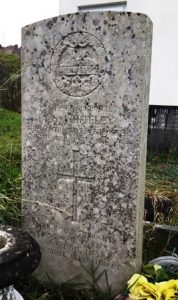Gilwern is a village within the Brecon Beacons National Park, inside the ancient county of Breconshire, and extends to either side of the River Clydach on the south side of the Usk valley. The village is situated about 3.5 miles west of Abergavenny, close to where the A40 trunk road and the A465 Heads of the Valleys Road meet. The men of the village who fell during both World Wars are commemorated on the Crickhowell and District War Memorial, which is situated in Crickhowell, near to the old site of the Crickhowell War Memorial Hospital. There is also a war memorial to the same men in Gilwern, situated next to the village Memorial Hall.
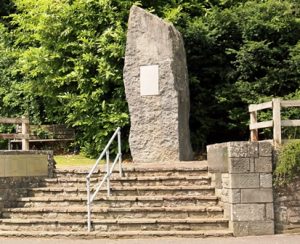
The Great War, 1914-1918
John Davies, Private, 37041, King’s Own (Royal Lancaster Regiment). John was the son of Joseph and Mary Ann Davies, of 5, Castle Road, Gilwern. He enlisted into the army early in 1918 and in March 1918 was drafted to France, joining the 8th Battalion, King’s Own (Royal Lancaster Regiment). The battalion was attached to 76 Brigade, 3rd Division and was holding a sector of the line near Hinges when John joined its ranks. On 9 May the battalion took up positions in the line near Locon and over the coming weeks rotated between Locon, Hinges and rest periods in Chocques. During the second week of August the Division began to move southwards to the Arras sector, in preparation to join the forthcoming offensive and took over positions at Berles-au-Bois. The great offensive opened at dawn on 21 August 1918 and the 8th King’s assaulted the German lines defending Courcelles. John was killed in action during an assault against the railway embankment at Courcelles that day. The 19-year-old has no known grave and is commemorated on the Vis-en-Artois Memorial, Haucourt, France.
Percy William Allen Drew, Private, 1933, South Wales Borderers. Percy was the son of William Drew and Charlotte Louisa Drew (nee Price), of Mill Street, Crickhowell. He worked as a groom prior to enlisting at Brecon into the 1st Brecknockshire Battalion, South Wales Borderers. The battalion had mobilised at Brecon attached to South Wales Brigade, Welsh Division, moving to Pembroke Dock and then Dale. On 29 October 1914 the battalion sailed from Southampton for Bombay, before transferring to Aden, where the battalion took part in a tragic crossing of the desert which saw a number of men die of heatstroke. In August 1915 the battalion embarked for India, arriving at Bombay, before spending the rest of the war on garrison duties in the country. Percy took ill soon after arriving in India and died in Colaba on 21 August 1915. The 20-year-old was buried in Suwri Cemetery, Bombay, but at some time afterwards the military graves were exhumed from there and reburied in a mass grave in Kirkee War Cemetery. As a result, Percy is commemorated on the Kirkee 1914-1918 Memorial, India.
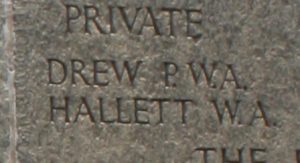
Albert Edward Flowers, Private, 33248, South Wales Borderers. Albert was born in Harpurhey, Manchester in 1893, the son of John Edwin and Anna Flowers (nee Bendall). His father was originally from Maesteg and after the turn of the century the family had moved to The Common, Gilwern. Albert’s mother died in 1910 and his father remarried to Catherine Ann Williams the following year. Albert worked as a surfaceman at the Six Bells Colliery prior to the war. He enlisted at Abertillery into the South Wales Borderers and was posted to Colwyn Bay to join the 11th Battalion, South Wales Borderers. In August 1915 the battalion moved to Hazeley Down, Winchester attached to 115 Brigade, 38th (Welsh) Division and embarked for France on 4 December, landing at Le Havre. The Division moved to the Nursery Sector near Fleurbaix for trench initiation alongside the Guards Division. Albert did not embark with the battalion but was drafted out to France in the Spring of 1916. The Division then held a sector of the line near Cuinchy before marching south to the Somme sector in June 1916 to take part in the assault on Mametz Wood. The first attack on the wood was launched on a two-battalion front on 7 July, with the 16th Welsh and the 11th SWB charging across the open expanse of Death Valley towards the wood. The two battalions became mown down by machine-gun fire and the initial assault failed. Albert was killed in action during the assault that day. The 21-year-old is buried in Flatiron Copse Cemetery, Mametz, France.
Walter James Isaac, Private, 28840, Somerset Light Infantry. Walter was the son of Benjamin Isaac and Mary Isaac (nee Griffiths), of Tyr Common, Gilwern. He worked as a Grocer at the Central Supply Stores, Llanbradach prior to the war. Walter married Lottie Maria Reed at Bedwellty Parish Church on 22 September 1915. He enlisted at Caerphilly into the Monmouthshire Regiment soon afterwards and upon being drafted to France in the autumn of 1917 was transferred to the 8th Battalion, Somerset Light Infantry, which was attached to 63 Brigade, 37th Division. Walter would have joined the battalion at Ypres, where the Division was taking part in the latter stages of the Passchendaele offensive. The Division wintered in the Ypres Salient, then in February 1918 was relieved, spending a short while behind the lines in reserve before moving south on 29 March to bolster the thinly stretched British lines on the Ancre, following the heavy losses suffered following the launching of the German offensive of 21 March. The Division took up positions on the Ancre soon after its arrival and on 5 April 1918 launched a counterattack against the Germans at Gommecourt, to attempt to regain some lost ground. The 8th Somerset’s were to have been supported in their assault to the southeast of Gommecourt by eight tanks, but they failed to arrive, so the infantry charged without support. Their first objective was carried but the battalion encountered fierce resistance at Rossignol Wood and suffered heavy casualties. Walter was killed in action during the days fighting. The 33-year-old is buried in Gommecourt British Cemetery No. 2, Hébuterne, France.
Arthur Edward Jones, Private, 88351, Machine Gun Corps. Arthur was born at Gilwern in 1885, the son of Aaron Jones and Eliza Jones (nee Meredith). By 1891 the family had moved to Latimer Village, Chesham, where Aaron worked as a shepherd on Lord Chesham’s large country estate, then by 1911 the family had moved to their own farm, Hillmeads Farm, at Sarratt, Rickmansworth. Arthur was working as a butcher at Ramsgate when war erupted, and he enlisted there into the Army Service Corps on 10 November 1915. Arthur then had several postings in Britain before being transferred to the Machine Gun Corps in March 1917 and was drafted to France on 6 May 1917, joining the 138th Company, Machine Gun Corps, which was attached to the 46th (North Midland) Division. Arthur arrived in France in time to take part in the latter stages of the Battle of Arras, and then fought near Loos during the Battle of Hill 70. The Division remained in the Loos Sector over the winter of 1917-18 and in February 1918 the 138th Company, MGC became merged with the other Companies in the 46th Division to form the 46th Battalion, Machine Gun Corps. The Division held the Beuvry Sector over the coming months, in relative peace, however on 9 April 1918 the Germans launched the second phase of their Spring Offensive along the Lys Valley and the 46th Division was kept busy on the flank of the desperate defensive action which ensued. Arthur was wounded by German gas shells whilst in the line near Gosnay on 1 May and was evacuated to the 1st North Midland Field Ambulance, before being sent to the 22nd Stationary Hospital, near Étaples. He died there of his gas wounds on 13 May 1918. The 33-year-old is buried in Étaples Military Cemetery, France. Arthur is not commemorated on the Gilwern war memorial.
George Jones, Private, 9793, South Wales Borderers. George was born in Gilwern in 1884, the son of Thomas Alfred Jones and Mary Elizabeth jones. He had enlisted into the South Wales Borderers as a young man and by 1911 was serving with the 1st Battalion, South Wales Borderers at Chatham. By the time that war erupted, George was in Tientsin, China, serving with the 2nd Battalion, South Wales Borderers. The battalion took part in a famous operation with the Japanese against the German held port of Tsingtao on 23 September. On 4 December the battalion embarked at Hong Kong and landed at Plymouth on 12 January 1915, entraining for Rugby to join 87 Brigade, 29th Division. On 17 March 1915 the battalion sailed from Avonmouth with the Division, arriving at Alexandria on 29 March, before moving to Mudros. On 25 April 1915 the Division landed at Cape Helles, Gallipoli, as part of the original landing force which had been despatched to try and seize the Dardanelles Straits and force Turkey out of the war. The invasion forces failed to break the Turkish defences and the campaign became bogged down, so after an arduous eight months on the Peninsula the 29th Division was evacuated to Egypt on 11 January 1916, before being transferred to the Western Front, landing at Marseilles on 15 March and entraining for the Somme sector, taking up positions near Beaumont Hamel, facing Y-Ravine. The Division had an arduous time here too over the coming months, before taking part in a suicidal assault on 1 July 1916, on the opening day of the Somme offensive. The 2nd SWB alone suffered some 384 casualties on that day alone. George was transferred back to the 1st Battalion, South Wales Borderers at some point. The battalion was heading for the Somme from Loos, attached to 3 Brigade, 1st Division, when the Somme offensive opened, and by 10 July had reached Albert. On 15 July the battalion left Albert for Lozenge Wood, preparing to move into the line near Mametz Wood and supported an assault by the 2nd Welsh on Bazentin Ridge the following day. After three days of fighting, the 1st SWB was relieved on 19 July and had a brief rest before moving back to Lozenge Wood by 23 July, then moved into the front line near Contalmaison. George was killed in action during heavy fighting at Munster Alley on 25 July 1916, while the Australians were assaulting Pozieres, just to the north. The 32-year-old has no known grave and is commemorated on the Thiepval Memorial, France. His soldiers war gratuity was left to Miss Eva Ann Botterill, of 186, Lawford Road, New Bilton, Rugby.

Gurnos John Jones, Private, 1518, South Wales Borderers. Gurnos was the son of Thomas and Emily Jones, of Maesgwartha, Gilwern. He worked as a labourer in a stone quarry prior to the war. Gurnos enlisted into the Brecknockshire Battalion, South Wales Borderers at Brecon prior to the war. The battalion had mobilised at Brecon attached to South Wales Brigade, Welsh Division, moving to Pembroke Dock and then Dale. On 29 October 1914 the battalion sailed from Southampton for Bombay, before transferring to Aden, where the battalion took part in a tragic crossing of the desert which saw a number of men die of heatstroke. Gurnos was among several men of the Brecknock’s who died of heatstroke on 4 July 1015. The 23-year-old has no known grave and is commemorated on the Heliopolis (Aden) Memorial, Egypt.
John Thomas Jones, Sergeant, 3904181, South Wales Borderers. John was the son of John Methusalem Jones and Jane Jones (nee Davies), of Church House, Gilwern. His father was the local Sexton. John worked as a plumber and pipefitter for David Willis, of Market Street, prior to the war. He enlisted into the Brecknockshire Battalion, South Wales Borderers on 8 September 1908 and over the following years attended the annual TA summer camps at Porthcawl, Aberystwyth and Haverfordwest. The battalion had mobilised at Brecon attached to South Wales Brigade, Welsh Division, moving to Pembroke Dock and then Dale. On 29 October 1914 the battalion sailed from Southampton for Bombay, before transferring to Aden, where the battalion took part in a tragic crossing of the desert which saw a number of men die of heatstroke. In August 1915 the battalion embarked for India, arriving at Bombay, before spending the rest of the war on garrison duties in the country. John remained in India after the Armistice, becoming attached to the Supply and Transport Corps. He died of disease at Nowshera on 21 July 1920. The 29-year-old was buried in Nowshera Military Cemetery, India, but is commemorated on the Delhi Memorial (India Gate), India.
Richard Lloyd, Shoeing Smith, 72324, Royal Garrison Artillery. Richard was the son of John and Margaret Lloyd, of Penyrheol Cottage, Gilwern. He worked as a farm labourer at Pant Farm, Llanellen prior to enlisting into the Royal Garrison Artillery at Abergavenny on 11 December 1915 and was sent to No 4 Depot, RGA at Newport. After completing his training, Richard was posted to France, joining the 24th Heavy Battery and over the coming months qualified as a Shoeing Smith. Richard served for over two years on the Western Front with the battery and on 14 November 1918 was granted two weeks leave, so returned home to his parents. Sadly, he became ill and died at home of influenza and pneumonia on 26 November 1918. The 32-year-old was buried in St. Ellyw Churchyard, Llanelly.
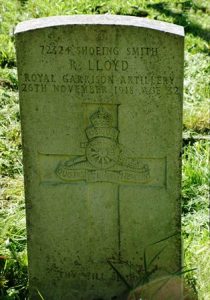
Albert Edward Makin, Private, 28934, South Wales Borderers. Albert was born at Leeds on 16 February 1898, the son of William Henry Makin and Sarah Jane Makin (nee Morgan). His father was originally from Leeds, and worked as a stone mason, and over the years the family had moved between various place, from Brecon to Abergavenny and then back to Leeds. By 1901 the family had moved back from Leeds to 5, Church Row, Chepstow, and then by 1911 Albert was residing with his aunt, the widowed Sarah Thornbury, at 6, Wilson Yard, Mill Street, Abergavenny. Albert moved to Gilwern to work after he left school, then enlisted at Brecon in the summer of 1916 into the South Wales Borderers. Upon completing his training, he was posted to Salonika to join the 8th Battalion, South Wales Borderers, which was attached to 67 Brigade, 22nd Division. The Division had been in Salonika since December 1915, helping to hold the Greek Frontier, as part of a Franco-English Force which had been sent there following the invasion of Serbia by the Austro-Hungarians. Albert was attached to the 67th Machine Gun Company after his arrival there. He was wounded during the early summer of 1918 and died of his wounds on 7 May 1918. The 20-year-old is buried in Karasouli Military Cemetery, Greece.
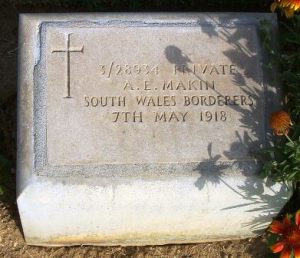
Trevor George Nash, Sapper, 229838, Royal Engineers. Trevor was born at Blaenavon in 1897, the son of Henry Nash and Juliette Emily Nash (nee Duck). By 1911 the family had moved to 110, St Helens Road, Abergavenny, where Trevor was educated. The family moved to Pine Grove, Maesgwartha, Gilwern prior to the war. Trevor worked as a Clerk for the London and North Western Railway at Abergavenny prior to enlisting in the town into the Royal Engineers on 16 February 1916 but was then placed on the Army Reserve. He was mobilised on 21 February 1917 and joined the Railway Operating Division, Royal Engineers at Camp Bordon, Hampshire. He then began training in preparation to move out to the Western Front. Sadly, soon after arriving at Bordon Trevor fell ill. He was taken to the Military Hospital at Fremisham Hill, where he died of tuberculosis on 22 February 1917. The body of the 19-year-old was brought home and he was buried in All Saints Churchyard, Clehonger, in Hereford, beside his mother who had died two years earlier.
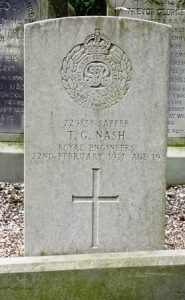
Thomas Edward Gordon Pickering, Private, Rhodesian Horse. Thomas was born in Gilwern in 1891, the son of Alfred Truscott Pickering and Edith Winifred Pickering (nee Pierce), of Auckland House. He left home as a young man to work in Rhodesia and whilst there enlisted into the Rhodesian Horse. Thomas was back home on holiday visiting his family at Gilwern during the time of the 1911 Census, but soon afterwards returned to Victoria, Rhodesia. He must have served throughout the war with the Rhodesian Horse but remained in Africa throughout the conflict. A month prior to the Armistice Thomas took ill and was taken to Holly Lodge Hospital, in the Cape. He died there of influenza and pneumonia on 1 November 1918. The 27-year-old was buried in Maryland, Southern Rhodesia. Nothing further is known of Thomas, as he is not commemorated by the CWGC. The Gilwern War Memorial states that he served with the South Wales Borderers, but there are no records to prove this.
James Sutherland, Private, 35325, Welsh Regiment. James was the son of Thomas Sutherland and Mary Margaretta Sutherland (nee Lewis), of Maesgwartha, Gilwern. He worked as a warehouse assistant at Brynmawr prior to enlisting into the Welsh Regiment at Brynmawr and in the spring of 1916 was drafted to the Middle East, joining the 8th Battalion, Welsh Regiment, which was the Pioneer Battalion to the 13th (Western) Division. The Division had fought during the Gallipoli campaign before being evacuated on 8 January 1916, and by 31 January was concentrated at Port Said, where it held forward posts in the Suez Canal defences. On 12 February 1916 the Division began to move to Mesopotamia, to strengthen the force being assembled for the relief of the besieged garrison at Kut al Amara. By 27 March, the Division had assembled near Sheikh Saad and came under orders of the Tigris Corps, and then took part in the attempts to relieve Kut. However, after these efforts failed and Kut fell, the British force in the theatre was built up and reorganised. The Division then fought at the Battle of Kut al Amara, then at the capture of the Hai Salient and the capture of Dahra Bend. It then took part in the passage of the Diyala, in the pursuit of the enemy towards Baghdad, and part of the Division became the first British troops to enter Baghdad. During the rest of March and April 1917, operations were undertaken to consolidate the position won at Baghdad, by pushing north across Iraq. James died of heatstroke in Mesopotamia on 24 July 1917. The 21-year-old is buried in Baghdad (North Gate) War Cemetery, Iraq.
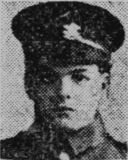
Arthur Edward Thomas, Private, 957, Essex Regiment. Arthur was born in Beckenham, Kent in 1879, the son of Thomas Jeremy Thomas and Mary Griffith Thomas (nee Lewis). His father was a warehouseman and merchant from Carmarthen, whilst his mother was from Abergwili. His mother died in 1891 and Arthur was sent to Millbrook School in Hampshire for his education. Arthur came to Gilwern to work at some time prior to the war. He had enlisted at Bradfield, Essex into the 1/5th Battalion, Essex Regiment some years prior to moving to Gilwern. The battalion mobilised at Chelmsford on 4 August 1914, as part of Essex Brigade, East Anglian Division, before moving to Norwich. In April 1915 the Division moved to Colchester where it became renumbered as the 54th (East Anglian) Division and on 21 July 1915 sailed from Devonport for Gallipoli. The Division landed at Suvla Bay on 12 August 1915 in order to join the last great push to seize the Peninsula. Unfortunately, the landings were a failure and the campaign bogged down into stagnant trench warfare again. Arthur took ill on Gallipoli and was evacuated by Hospital Ship to the 15th General Hospital at Alexandria, in Egypt, where he died of dysentery on 27 September 1915. The 36-year-old is buried in Alexandria (Chatby) War Memorial Cemetery, Egypt.
Albert James White, Private, 290465, Monmouthshire Regiment. Albert was the son of William and Mary Annie White, of Maesgwartha, Gilwern. He enlisted into the 3rd (Reserve) Battalion, Monmouthshire Regiment at Abergavenny on 17 September 1914 and was posted to Northampton with the 68th (2nd Welsh) Division. Albert embarked for France at Southampton on 13 March 1917 and was posted from the Infantry Base Depot at Rouen to the 1st Battalion, Monmouthshire Regiment, which was the Pioneer Battalion to the 46th (North Midland) Division. Albert joined the battalion at Ecqueldecques, near St. Hilaire, where it was refitting. The Division was in the Bully-Grenay Sector near Loos and in May 1917 fought in the Battle of Arras, taking part in the Battle of Hill 70. The Division remained here over the coming months, whilst the fighting moved north to Passchendaele, so had a relatively quiet time for the remainder of 1917, with the 1st Monmouth’s kept busy on work around Mazingarbe and Cambrin. The battalion then began work around Sailly-Labourse in September 1917, remaining here for the winter. Albert was taken ill in February 1918 and was evacuated to the 34th Field Ambulance before being sent to the 1st Casualty Clearing Station at Chocques, where he died of appendicitis on 28 February 1918. The 21-year-old is buried in Chocques Military Cemetery, France.
World War Two, 1939-1945
Joseph Fear, Sergeant, 2216622, Royal Air Force Volunteer Reserve. Joseph was the son of Joseph Fear and Winifred Fear (nee Pritchard), of Maesgwartha, Gilwern. He enlisted into the Royal Air Force Volunteer Reserve and after training as a Flight Engineer was posted to 207 Squadron, Royal Air Force, which was a heavy bomber squadron, based at RAF Spilsby, in Lincolnshire. On the night of 7 July 1944, Joseph took off from Spilsby aboard Avro Lancaster I, Serial LM218, which formed part of a large force despatched to bomb the V-1 Storage Site at St Leu-D’esserent. During the early hours of 8 July 1944, the Lancaster crashed near Haudricourt, some three miles from Aumale, with the loss of five of her crew of seven. Joseph was 20 years old when he was killed in the crash that morning. He is buried alongside his fellow crewmen in Haudricourt Communal Cemetery, France.
Donald Arthur Ivor Lewis, Sapper, 2155478, Royal Engineers. Donald was born on 17 June 1922, the son of William Lewis and Jessie Lewis (nee Howe), of Twynwenallt Farm, Gilwern. He worked as a carpenter’s labourer at Gilwern prior to enlisting into the Royal Engineers and was posted to 271 Field Company, Royal Engineers, which was attached to the 46th (North Midland) Division. The Division fought in North Africa with the 8th Army, before taking part in the liberation of Sicily in 1943, then landed in mainland Italy to begin the long slog northwards to drive the Germans out of the country, which had by now surrendered. Donald was killed in Italy on 4 September 1944 during the crossing of the Foglia River, which was part of the German Gothic Line defensive system. The 22-year-old was originally buried on the battlefield, but in May 1945 his grave was exhumed, and Donald was re-interred in Montecchio War Cemetery, Italy.
Victor Irving Powell, Gunner, 4081131, Royal Artillery. Victor was born on 3 November 1915, the son of William Henry Powell and Elizabeth Maud Powell (nee Lloyd), of 1, Castle Cottages, Gilwern. He worked as a dumper driver at Gilwern prior to the war. Victor married Frances Margaret Beryl Griffiths, of Holdenhurst, Cardigan, at Cardigan in 1941. Victor enlisted into the Royal Artillery and was posted to 311 Battery, 90th Light Anti-Aircraft Regiment, Royal Artillery. The battery took part in the North African campaign. Victor was killed in Tunisia on 20 April 1943, aged 27. He is buried in Medjez-El-Bab War Cemetery, Tunisia.
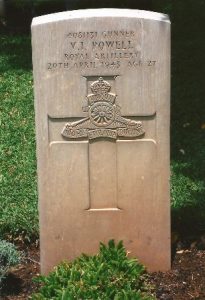
David Pryce Rawlings, Sergeant, 526314, Royal Air Force. David was born on 30 March 1915, the son of William Joseph Rawlings and Margaret Rawlings (nee Lewis), of Wilma Shop, Gilwern. He enlisted into the Royal Air Force prior to the war and by 1939 was based at RAF Filton, where he was training as a pilot. David lodged at 37 Callicroft Road, Patchway, Bristol whilst based at Filton. Upon completing his training, he was posted to 148 Squadron, Royal Air Force, which had reformed at RAF Scampton on 7 June 1937, equipped with the Hawker Audax and the Vickers Wellesley. David was then posted to RAF Luqa at Malta with the Wellington Detachment from the Squadron. On 4 November 1940, David took off from Luqa flying Vickers Wellington Ic, Serial R1094, on a raid on the Italian town of Naples. The Wellington lost power on take-off and crashed into houses at Qormi, killing David and his entire crew. The 25-year-old was buried with his fellow crewmen in Malta (Capuccini) Naval Cemetery, Malta.
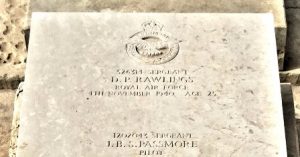
James Kenneth Sutherland, Captain, 79853, Royal Army Medical Corps. James was the son of James Sutherland and Janet Sutherland (nee Rorrison), of Glen Caion, Gilwern. His parents were both Scottish born but had lived at Gilwern for many years. James studied medicine at Edinburgh after leaving school and qualified M.B.Ch.B., M.R.C.O.G. He practised at Edinburgh after qualifying as a doctor and married a fellow Doctor, Joan Kennedy Cunningham at St. Andrews Church, Edinburgh on 16 September 1939. James was by then serving as a Lieutenant in the Royal Army Medical Corps, after having volunteered following the outbreak of war. He was posted to France with a Royal Artillery unit of the BEF and was wounded during the withdrawal to Dunkirk. Upon being brought ashore in England, James was taken to Ashbridge Hospital, Berkhamsted, where he died of his wounds on 27 May 1940. The remains of the 29-year-old were brought home and he was buried in St. Ellyw Churchyard, Llanelly.
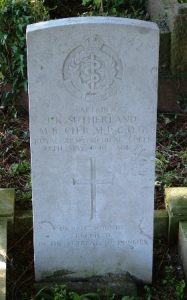
Arthur Selwyn Whiteley, Corporal, 3909917, South Wales Borderers. Arthur was the son of James Henry Whiteley and Beatrice Gwendoline Whiteley, of Crickhowell Road, Gilwern. He enlisted into the South Wales Borderers and was posted to the 2nd Battalion, South Wales Borderers. The battalion had taken part in the Battle of Norway in 1940 before its survivors were evacuated back to Britain and spent most of the war in Britain. It then began preparing to take part in the Normandy Landings, being the only Welsh unit selected to land on the opening day, D-Day, on 6 June 1944. The battalion saw heavy fighting during the landings, when it seized a radar station and by nightfall the bridge at Vaux-sur-Aure had been captured intact. The battalion saw heavy fighting around Caen later in the Normandy campaign, before taking part in the drive through Northern France into Belgium and Holland, before crossing the Rhine into Germany in the spring of 1945. By now Arthur had been invalided home and he died at Basingstoke on 16 April 1945. The remains of the 26-year-old were brought home and he was buried in Llanwenarth Baptist Chapelyard.
